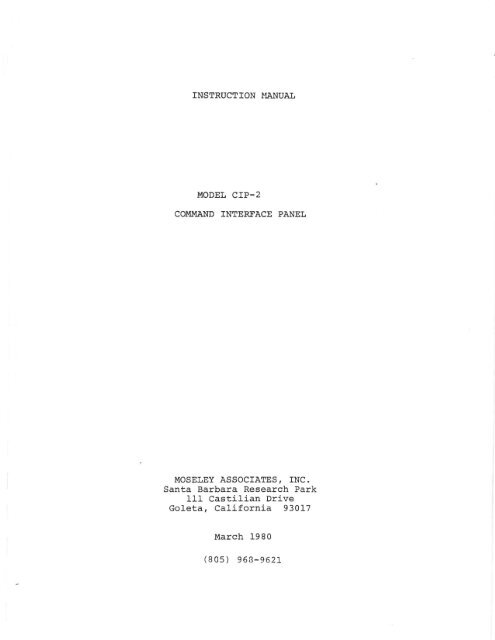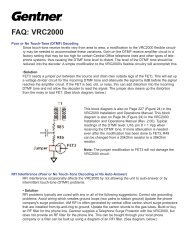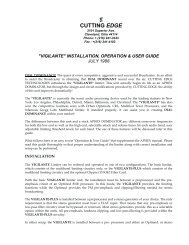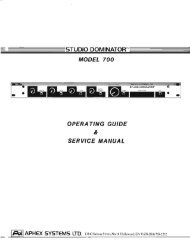CIP-2 - Hallikainen.org
CIP-2 - Hallikainen.org
CIP-2 - Hallikainen.org
Create successful ePaper yourself
Turn your PDF publications into a flip-book with our unique Google optimized e-Paper software.
INSTRUCTION l1ANUAL<br />
MODEL <strong>CIP</strong>-2<br />
COMMAND INTERFACE PANEL<br />
MOSELEY ASSOCIATES, INC.<br />
Santa Barbara Research Park<br />
111 Castilian Drive<br />
Goleta, California 93017<br />
March 1980<br />
(805) 968-9621
<strong>CIP</strong>-2 COMt-IANO INTERFACE PANEL<br />
Schematic 91C7184<br />
Assembly 2102681<br />
Component Layout 2002756<br />
I. PURPOSE<br />
The <strong>CIP</strong>-2 Command Interface Panel is designed to provide a<br />
simple control interface for use with the Moseley MRC-l<br />
Microprocessor-Based Remote Control System. When used in<br />
conjunction with an Open Collector or an Optically-Isolated<br />
Output Board, up to sixteen control rel~ys may be operated<br />
in a single Command Interface Panel. Both normally-open and<br />
normally-closed relay contacts are available at each relay<br />
position. Unregulated OC power is also available at the<br />
spare power terminals for user convenience.<br />
II.<br />
SPECIFICATIONS<br />
The <strong>CIP</strong>-2 Command Interface Panel is designed to operate in<br />
conjunction with the MRC-l Open Collector Output Board,<br />
20C2755-1, or the Optically-Isolated Output Board, 20B2705.<br />
WARNING: Improper operation will result if the <strong>CIP</strong>-2 is used<br />
in conjunction with the Modified Open Collector Output Board,<br />
20C2755-2.<br />
Outputs<br />
Number of Contacts<br />
Up to sixteen normally-open or<br />
normally-closed relay contacts<br />
<strong>CIP</strong>-2 Command Interface Panel (9lC7l84)<br />
7 March 1980<br />
-1-
Termination<br />
Initial Contact<br />
Resistance<br />
Contact Rating<br />
(Resistive Load)<br />
Contact Rating<br />
(Inducti ve Load)<br />
Maximum Operating Speed<br />
Operate Time<br />
Release Time<br />
Spare Power Output<br />
Voltage<br />
Spare Power Output<br />
·Current<br />
Wire-clamp barrier terminal blocks<br />
100 milliohm maximum<br />
SA @ 125 VAC, 250 VAC or 30 VDC<br />
1/10 hp @ 125 VAC or 250 VAC<br />
50 c/s<br />
Approximately 10 ms<br />
Approximately 5 ms<br />
+28V unregulated<br />
25 rnA to 281 rnA depending on the<br />
number of relays installed in<br />
the <strong>CIP</strong>-2.<br />
CAUTION: See Section IV, INSTAL<br />
LATION, in this manual for limitations<br />
on current demands above<br />
25 rnA.<br />
Inputs<br />
Number of Inputs<br />
Termination<br />
Drive Requirements<br />
Power Requirements<br />
Operational Temperature<br />
Range<br />
16 active lines and 16 ground<br />
returns<br />
37-pin "D" connector<br />
An NPN open collector (or switch<br />
to ground) able to withstand<br />
+35V open circuit voltage and<br />
22 rnA short circuit current for<br />
each relay. These drive requirements<br />
are met when the <strong>CIP</strong>-2 is<br />
driven by the Open Collector<br />
Output Board, 20C2755-1, or the<br />
Optically-Isolated Output Board,<br />
20B270S.<br />
120 VAC or 240 VAC ±lO%<br />
O°C to +50 Q C<br />
<strong>CIP</strong>-2 Command Interface Panel (91C7184)<br />
7 March 1980<br />
-2-
III.<br />
UNPACKING<br />
The <strong>CIP</strong>-2 should be carefully unpacked and inspected for any<br />
shipping damage. Keep all packing material until performance<br />
is verified. Should inspection reveal shipping damage,<br />
or should hidden damage be revealed, immediately file<br />
a claim with the carrier. This inspection should include<br />
ascertaining that all the various components are mechanically<br />
secure.<br />
IV.<br />
INSTALLATTON<br />
Prior to installation of the <strong>CIP</strong>-2, ensure that all relays<br />
are mechanically secure in their sockets.<br />
The <strong>CIP</strong>-2 comes factory-wired for 120 VAC operation. If<br />
240 VAC operation is desired, the primary lines of the power<br />
transformer can be reconnected, as shown in Schematic Diagram<br />
9lC7l84. These lines are located on the power barrier<br />
strip next to the fuse holder. Extra space is provided for<br />
the 240 VAC connection.<br />
The <strong>CIP</strong>-2 Command Interface Panel is designed to be rackmounted<br />
within two feet of the MRC-l Microprocessor. The<br />
unit comes supplied with extender brackets which are useful<br />
for rear rack mounting configurations. However, these extender<br />
brackets should be removed when the <strong>CIP</strong>-2 will be<br />
mounted on the front of a rack.<br />
After the <strong>CIP</strong>-2 is secured to the rack, its input "D" connector<br />
should be connected to the output of the appropriate<br />
filtered I/O board. In turn, this I/O board should be connected<br />
to either an Open Collector Output Board, 20C2755-l,<br />
or an Optically-Isolated Output Board, 20B2705.<br />
<strong>CIP</strong>-2 Command Interface Panel (91C7l84)<br />
7 March 1980 -3-
WARNING: Improper operation will result if the <strong>CIP</strong>-2 is <br />
used in conjunction with the Modified Open Collector Output<br />
Board, 20C2755-2.<br />
AC power may now be connected to the <strong>CIP</strong>-2.<br />
The <strong>CIP</strong>-2 relay outputs are located on the two large barrier<br />
terminal blocks which are situated along the top and<br />
bottom of the PC board. These terminal blocks are electrically<br />
connected to the relay contacts and are labeled Kl<br />
through K16. KI is actuated by Command Channell from the<br />
Command Output Board. K2 through Kl6 are controlled, respectivaly,<br />
by Command Channels 2 through 16. If more than<br />
one <strong>CIP</strong>-2 is used, then Kl through Kl6 on the second <strong>CIP</strong>-2<br />
are controlled, respectively, by Command Channels 17<br />
through 32 from the second Command Output Bo~rd. Relay<br />
control may be expanded in this manner up to 64 channels.<br />
Each relay output has three connections associated with it:<br />
"C", or common line~ "NO", or normally-open contact~ and<br />
"NC" , or normally-closed contact. "Normally", in this case,<br />
indicates the relationship between the relay contacts and<br />
the common line when the relay coil is not energized. Lines<br />
to the externally-controlled equipment should be connected<br />
to the appropriate relay terminal blocks. These terminal<br />
blocks feature wire-clamping screws which eliminate the<br />
need to lug wires. For 5-ampere service, use 16-gauge wire.<br />
Spare DC power is available at the spare power terminal<br />
block located on the <strong>CIP</strong>-2 PC board. The voltage at these<br />
terminals is 28 VDC unregulated with an output current<br />
capability between 25 rnA and 281 rnA, depending on the number<br />
of relays installed in the <strong>CIP</strong>-2. A formula for deter-<br />
<strong>CIP</strong>-2 Command Interface Panel (91C7184)<br />
7 March 1980 -4-
mining the allowable spare power current capability for a<br />
given number of relays is;<br />
I rnA = 28l-N (16)<br />
where N is the number of relays installed. For example, if<br />
the <strong>CIP</strong>-2 contains eight relays, a maximum of 153 rnA can be<br />
drawn from the spare power terminals.<br />
v. THEORY OF OPERATION<br />
The following description is with reference to Schematic<br />
Drawing 9lC7l84.<br />
Transformer Tl, in conjunction with diodes CR17, CR18 and<br />
filter capacitor, C3, form a full-wave 28 VDC unregulated<br />
power supply with sufficient capacity f6~ powering sixteen<br />
16 rnA relays. Capacitors Cl, C2 and C4 perform the function<br />
of RF filtering, while resistor Rl improves the load regulation<br />
of the power supply. Since the full current capability<br />
of the supply is not needed for driving relays, external<br />
access to the supply is provided through the spare power<br />
terminals and fuse Fl. The amount of current that can be<br />
drawn from this source (which depends on the number of<br />
relays installed in the <strong>CIP</strong>-2) is defined in Section IV,<br />
INSTALLATION.<br />
To conserve space, the relays used in the <strong>CIP</strong>-2 are magnetically<br />
(as opposed to mechanically) biased. This requires<br />
that coil power be of proper polarity. Therefore, the positive<br />
line of the power supply connects to the positive coil<br />
inputs on relays Kl through K16. Diodes CRI through CR16<br />
serve as transient snubbers to suppress turnoff transients<br />
which might otherwise damage the relay drivers.<br />
<strong>CIP</strong>-2 Command Interface Panel (9lC7l84)<br />
7 March 1980 -5-
The negative coil lead of each relay is brought out to a<br />
37-pin 110" connector. Pins 1 through 16 of this connector<br />
are connected respectively to relays Kl throug~ K16, and<br />
pins 20 through 35 function as ground returns. Relay Kl<br />
will be activated by a low impedance connection between<br />
pins I and 20. This connection may be affected by an open<br />
collector gate or a switch. The worst case open circuit<br />
voltage across these pins is 35 VDC. The worst case short<br />
circuit current through these pins is 22 mAo The other<br />
relay control pins function similarly.<br />
Each relay has a common lead, a normally-open contact and<br />
a normally-closed contact, all of which are connected to<br />
wire-clamping terminal blocks, where connections to externally-controlled<br />
equipment are to be made. ~pe non-inductive<br />
current-carrying capacity of these contacts is SA<br />
maximum.<br />
VI • TROUBLESHOOTING<br />
A. Partial Failure (Some Relays Work)<br />
This indic~tes<br />
that the <strong>CIP</strong>-2 power supply is operating<br />
correctly. One possible problem could be a faulty relay.<br />
Try exchanging this relay with one from a functioning channel.<br />
If the bad channel still does not work, determine<br />
if the relay is pulling in (there should be an audible<br />
click upon activation). If the relay is pulling in but<br />
there is no change in the output, then the problem is a<br />
break between the relay contacts and the output barrier<br />
strip. However, if the relay is not changing state on<br />
command, there is either a fault in the <strong>CIP</strong>-2 or the MRC-l<br />
Command Output Board. A test to isolate the unit at fault<br />
is as follows:<br />
<strong>CIP</strong>-2 Command Interface Panel (91C7184)<br />
7 March 1980 -6-
Disconnect the <strong>CIP</strong>-2 "D" connector from its mating<br />
"D" plug on the filtered I/O board and carefully<br />
inspect the pins on both connectors. If, -for example,<br />
relay K4 were inoperative, use a small screwdriver and<br />
short pins 4 and 23 in the <strong>CIP</strong>-2 liD" connector together.<br />
If the relay operates properly under this condition,<br />
the problem lies either in the MRC-l Command Output<br />
or filtered I/O board, and their respective manuals<br />
should be consulted. However, if the relay still does<br />
not operate, then there is likely an open or short in<br />
the PC board trace or the connector cable of the <strong>CIP</strong>-2<br />
that corresponds to this relay.<br />
B. Complete Failure (No Relays Work)<br />
The most probable cause of this condition is the power<br />
supply. Check the cO,nnection to AC mains and fuses F 1<br />
and F2. The voltage at the spare power terminals should<br />
be 28V ±20%.<br />
If the power supply is functioning properly" then the<br />
fault is either a faulty Command Output Board or an improperly<br />
connected system. Check the <strong>CIP</strong>-2 connections<br />
to the MRC-l with referen-ce to Section IV, INSTALLATION.<br />
If this seems normal, then troubleshoot the appropriate<br />
Command Output Board with reference to its manual.<br />
WARNING: Improper operation will result if the <strong>CIP</strong>-2 is<br />
used in conjunction with the MRC-l Modified Open Collector<br />
Output Board, 20C2755-2. Refer to Section II, SPECIFICATIONS,<br />
for proper Command Output Board selection.<br />
<strong>CIP</strong>-2 Command Interface Panel (9lC7l84)<br />
7 March 1980 -7-
¢~ -v 81 L ~ 16 \1.l. · ~I ·'" _ '> ~.q l ,N, >- I~<br />
~<br />
I~<br />
t:-, ." ,-~ ~~ 1 ~"'<br />
-.s.<br />
-- - ; -V:;' ~ ~ ~~ ~<br />
lfI::Jm 0;",<br />
-!'. 11 ~ ,...<br />
", Or" .. ~<br />
.., .... ~.,-: 1:J'~ I NMO -..<br />
- ~ Om ~~ : N 7:- I : -::'::i<br />
;:::-'" g~<br />
-tc?~e ~ - ....<br />
.uL:" ::r "nr = xxr "ID'" - 'IT "a.l 1 :' .~....., 11'1.1"<br />
., - :: .:: J - ~" I. ::
"<br />
q<br />
:~l<br />
CR I<br />
~.<br />
~I.KS",_<br />
t 3]<br />
r-------- eel<br />
[D]<br />
cz1<br />
r"j<br />
I ' , , , , , , , , ,.<br />
:- --- -~·J -1--1-J-1·+ -1l-+ -i- -h1·++ +·~· c<br />
~R,~~I:~-":ON '\ 'I JI ~ \ '-1 'I 11 11 ' I ,01 II I ILl 'JT I f 1 II"I 1· 1 "<br />
·.-: I\!'';\:'-, : ·)R<br />
- -~ - -/~- -/~--<br />
1V1 ,t l l , j 1J<br />
I<br />
I I ! !<br />
--1--~--t--1_-<br />
liT "'Ill<br />
I<br />
. i<br />
CGl<br />
Cs)<br />
r I t I I<br />
.,<br />
T ; , , .,<br />
z, ~ II .3 l7- if<br />
INPU"\ "D" :ONNE CT 0 R<br />
I<br />
~ ., I I<br />
f<br />
Z,J S 2.~<br />
I I I<br />
t t f<br />
, l, t I<br />
7<br />
t t t<br />
1<br />
I I I<br />
"f t ~ ., 1<br />
,<br />
Z'" '1 .. 7 ~ 28 I I) l'! 3b ' l..<br />
,<br />
I I<br />
,<br />
31 13<br />
iRAN'5FORN\E~ C.ONNECTION<br />
FOR 240VAC. OPERATION<br />
BLK<br />
~<br />
~<br />
W:::J<br />
.I<br />
NOTES:<br />
1. ALL QIODES ARE 1002..<br />
F2<br />
3-I Q 86<br />
11<br />
(Jo~.<br />
':lLO 3LQ<br />
-RI7<br />
-,,. . " .- .<br />
~ \J I .-rO<br />
r<br />
w ) . ~<br />
I I (_1 .. ,,~ - . '" I •<br />
rh<br />
? T .1/ 75<br />
~ > ••<br />
'- --<br />
:;J<br />
:l::J
C~l<br />
12. 1.1 I S'"<br />
"<br />
"1<br />
:.] i i, I • ! I !<br />
I I I<br />
3 ] •• •• •• •• •• •• ••<br />
1 e ~ I do +<br />
i £J) KIO t Ell KII<br />
,,,or ¥ _<br />
C~ 12<br />
'R" j ¥ _<br />
II KI 6<br />
[cl _ ___<br />
________ ___<br />
[::) ----------- ---'<br />
C?)<br />
G) • I . •<br />
,,' -1--1--1.1- -~- -~--<br />
", nl L~ .~ ~ I ~I n<br />
"'f 13<br />
lZ I ..<br />
v v v v v v v ~<br />
~ ~ ~ ~ ~ ~ ~ ~<br />
-~- -~ - -~- -~- -li --~--t--l---~<br />
.r ~T .. f '" • "I ",'" :<br />
,<br />
~ ~ ~ I<br />
'tt~, , tl '<br />
J I> 3+" " 1(' 17 31. I r 37 19<br />
I<br />
I<br />
SPARE POWER<br />
.2SA<br />
SLO SLO<br />
_ __ -1<br />
- 24 V OC<br />
•<br />
r<br />
- I 0 L40 ,- -- - - - - - - -- - - - - ______ J<br />
.....L ISOO -<br />
.<br />
;!<br />
, 1114.! 'd>o 6
\ ""-\<br />
2?t.r!@'-..,.<br />
"<br />
141'/<br />
/.<br />
/j<br />
"<br />
~<br />
.... .- _. J<br />
(TiJ 0<br />
J<br />
<br />
./<br />
/<br />
' ,-~g,.i.CS<br />
(I)<br />
@<br />
@<br />
~)<br />
I<br />
. ~<br />
£) 5V<br />
/<br />
./<br />
r<br />
~O,llt COMPONENT SIC.S S~C ZOD27S~<br />
,PLCS<br />
,-<br />
liS}<br />
,.{<br />
@@<br />
f'/OT'£S :<br />
I. All w>\,€s ~1IS""/8 GAUGE Vf'lLrS'3 'IOTE"D .<br />
... • CHlo·"l4r/c IS 91C71df, C(D<br />
rn THE" llII5H 1't7. FOLLolAJIN6 eID2.SI INO/CATES TI~ (IllJANnTY<br />
Q~ ITEM 1.$ tr'£fP£D. U/Sf.ALL "1J"~T'Ty' ~ IYr.1'I\ I' Ct4"ONOLO'IC"ll'(<br />
ST.e nf\l6 ""ITIl SO
m<br />
28 WAS,Io/ER, FLA"T' &'-10 l/sOI4f3T4-<br />
27 NYLON SPAC5R)7FrOt~ 1.3-00l.3ST.2<br />
2.6 '-OCKWA~H~ #4-I. T. fQ£ObZ'1 f 8<br />
25 SCR~W#-+-4~g'l?l,.roN :;'IIDDD~ 3<br />
12 POWER CORD '¥..7j~'1: 3;37DD2.0 1<br />
II , G..5~~'XB~G'':!-'?3+ I<br />
10 !INSULATING COVE"R '::¢ etJb03/7 ; I<br />
9 Itv:':'~~~~;R~~_4 j2."tD'1/e /<br />
8 IPOWeR XFMR. ~ -/n.&il.~ TI u QO~<br />
IlVcLeo 8-/::';:;'7'6--- I ,0, ~/2.. I<br />
7<br />
I P;RAIN R£'LJE'~.'3u.srlING 1'-"70''-''' /<br />
• .sMI-r~ 93"i '- au ,<br />
6 i ~~:ff~~ND4E"j!KP .3.370.3::51 1<br />
s 1 ~~IDf.i.8~1:,~A,e50V , ':-11~702.2B 1<br />
1--4 ,€"XTli'NC£R ERACK£,T I ~' WbOS07 ~<br />
3 : U - BI
"I<br />
¢,: ~Sl"t~ 1.,-0'-'" .",-:; •• J ~ I 1 =::> "51- t¢ l.,..,<br />
I .. :....,.'-~ ......,..,.~ ."':<br />
c ,<br />
11''-'' ...«_n"!' L I . -,.,. ' . v- wac !- 1",,"1I;P II In., .•.,. r' ~_<br />
..vl :: ..., ... S I<br />
~ TTl<br />
, ' & . , :- -crt'.., ""'lIe...<br />
"<br />
:; ~ ~ lO~;" 0';;" I<br />
~ .If=Z£. ::13 N'i
01- 'A3t'-"Bi~O\; O~VO'B -'CI "Z<br />
¢.::>.eILOI~ "f.l.'fV"l;~ '1<br />
:S310N<br />
@<br />
--~~~~--~~~--~ ~<br />
@<br />
--
'WI' .: tr "'. 1 -: ',-="a, .l'\cu<br />
1 \Ii.:...U .<br />
- i<br />
-<br />
£<br />
,<br />
l' I<br />
.5<br />
s I<br />
t<br />
~<br />
b<br />
0 1 I<br />
II I<br />
J I I I J<br />
Ol-UHOI<br />
/





